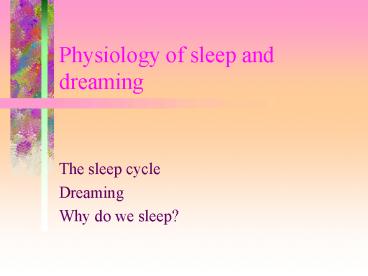Physiology of sleep and dreaming - PowerPoint PPT Presentation
1 / 18
Title:
Physiology of sleep and dreaming
Description:
Narrative dreaming. CBF is high to visual cortex, low to inferior frontal cortex (Madsen, 1991) ... Cats, dogs, rodents: 12-15 hours daily. Ruminant herbivores: ... – PowerPoint PPT presentation
Number of Views:191
Avg rating:3.0/5.0
Title: Physiology of sleep and dreaming
1
Physiology of sleep and dreaming
- The sleep cycle
- Dreaming
- Why do we sleep?
2
The sleep cycle
- Electronic recording EEG, EOG, EMG
- EEG patterns divide sleep into four stages
- 1 a waves, 8 - 12 Hz, low amplitude, moderate
frequency, similar to drowsy wakefulness - 2 slower frequency, higher amplitude, plus
- K complexes
- Sleep spindles
- 3 d waves appear, 1-2 Hz, large amplitude
- 4 Dominated by d waves
3
REM sleep phenomena
- Stage 1 EEG Paradoxical sleep
- EOG (and corneal bulge) show frequent eye
movements, as if scanning a visual field. - EMG shows loss of muscle tonus due to downward
inhibition of a motor neurons, although muscles
moving hands and feet may twitch. - Many brain structures function as if awake.
4
More REM phenomena
- SNS is partially activated Increases blood
pressure, respiration, and heart rate. - Genital erection or partial erection Postage
stamp test. - Narrative dreaming
- CBF is high to visual cortex, low to inferior
frontal cortex (Madsen, 1991) - Eye movements match dream events
- One EEG waveform is unique to REM and wakeful
scanning
5
Dream research
- External stimuli may be incorporated into a
dream. - Dream events happen in real time.
- Everyone dreams recall depends on when in the
sleep cycle you awaken. - Genital response is independent of dream content.
- Sleep-walking and talking are non-REM.
6
Interpretation of dreams
- Manifest content is symbolic of latent desires
(Freud) - Activation-synthesis theory cf. incorporation of
external events into dreams. - Lucid dreams Have you had one?
7
Why do we sleep?
- Restoration, recuperation or repair
- Waking life disrupts homeostasis
- Protection with the circadian cycle
- Circadian synthesis
8
Who sleeps?
- Mammals and birds
- Opossums, sloths, bats 19-20 hours daily
- Cats, dogs, rodents 12-15 hours daily
- Ruminant herbivores 2-3 hours daily
- Reptiles, amphibians, fish, and insects have
cycles of inactivity - Note that sleep time does not correlate with
waking activity levels, but does relate to waking
vulnerability.
9
Two interesting variations on sleep
- Cetaceans
- Indus dolphin
- Bottlenose dolphin and porpoise
- Flocking birds
10
Circadian rhythms
- Zeitgebers and the SCN
- Free-running rhythms and the 25-hour period
- Sleep deprivation within a circadian cycle is
followed by less sleep, not more - Internal desynchronization free-running body
temperature cycle and sleep-wake cycle may
desynchronize.
11
Resynchronization
- Jet lag and shift work
- Phase shift Delay is better than advance
- Morning melatonin phase-delays
- Afternoon melatonin phase-advances
- Evening melatonin is ineffective
- Bright light exposure has the opposite effects
- Strengthen zeitgebers like light and activity
early in the new waking period
12
Sleep deprivation
- Under total, voluntary sleep deprivation,
sleepiness is cyclical - Greatest sleepiness from 3-6 a.m.
- Waking sleepiness is countered by activity
- Sleepiness increases only up to four days
- Active, complex tasks are not impaired
- Easy, boring tasks are impaired
- Microsleep emerges
13
Compensation for sleep deprivation
- Subsequent slow-wave, non-REM sleep is increased
- Stage 3 and 4 sleep is almost completely restored
- Involuntary sleep deprivation is stressful
- Executive rats on a carousel apparatus died
- Post-mortem exams showed stress symptoms
14
REM deprivation
- REM pressure
- REM rebound
- REM escape
- Three theoretical effects
- Mental disorder
- Amotivational syndrome
- Memory processing deficits
- But tricyclic antidepressants block REM with none
of these side effects.
15
Neural control of sleep
- Is sleep a passive process?
- The cerveau isole of Bremer (1936)
- The encephale isole and the RAS
- Partial transections leaving the RAS intact
- Ventrolateral Preoptic Area (VPA) triggers
sleepiness and slow-wave sleep - Warming the basal forebrain induces slow-wave
sleep - VPA receives input from thermoreceptors
16
More neural control
- PGO waves in the EEG from implanted electrodes
- Executive in the dorsolateral pons, called the
peribrachial area. - Kainic acid lesions of peribrachial area reduce
REM sleep - Carbachol, and ACh agonist, in ventral pons
(medial pontine reticular formation) triggers REM
phenomena.
17
EEG patterns
b
1 a
2 k
3 d
1 sec
18
EEG patterns...
4 d
1 sec































